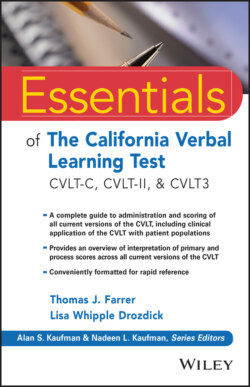Читать книгу Essentials of the California Verbal Learning Test - Thomas J. Farrer - Страница 12
Rapid Reference 1.3 Primary Scores Derived in CVLT-II, by Condition
Оглавление| Learning trials | Recall scores | Recognition scores |
| Trial 1 Free-Recall Correcta Trial 2 Free-Recall Correcta Trial 3 Free-Recall Correcta Trial 4 Free-Recall Correcta Trial 5 Free-Recall Correcta,b Trials 1–5 Free-Recall Correct (T score)a List B Free-Recall Correcta,b List B vs. Trial 1 (contrast score) Semantic Clustering (Chance-Adjusted) Semantic Clustering Bidirectional (Chance-Adjusted) | Short-Delay Free-Recall Correcta Short-Delay Cued Recall Correcta,b Short-Delay Free Recall vs Trial 5 (contrast score) Long-Delay Free-Recall Correcta Long-Delay Cued Recall Correcta Long-Delay Free Recall vs. Short-Delay Free Recall (contrast score) Free-Recall Intrusionsa Cued-Recall Intrusionsa | Long-Delay Yes/No Recognition Total Hitsa Long-Delay Yes/No Recognition Total False Positivesa Total Recognition Discriminability (d') Total Recognition Discriminability vs. Long-Delay Free Recall (contrast score) Total Response Bias Long-Delay Forced-Choice Recognition Percent Total Accuracya |
| Subjective Clustering (Chance-Adjusted)Percent Recall from PrimacyPercent Recall from MiddlePercent Recall from RecencyTotal Learning Slope Trials 1–5Across-Trial Recall Consistency | Total Intrusionsa Total Repetitionsa Total Recall Discriminability |
aScores that are easily hand scored.
bScores not on the Short Form.
Difference scores compare performance on one task to performance on another task. On CVLT-II, difference (or savings) scores are derived using the sex- and age-corrected z-scores. Change and difference scores should not replace the primary scores but are used to guide interpretation of differences observed across conditions. Detailed information on the interpretation of scores is provided in Chapter 4.
